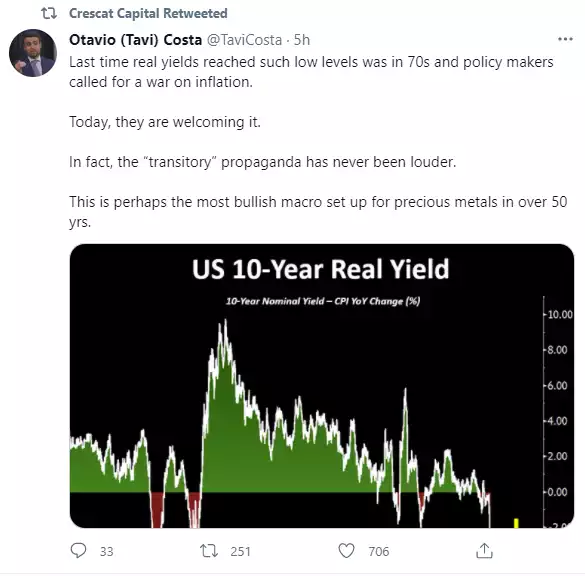US Inflation Shock – Testing the Transitory Narrative
News
|
Posted 11/06/2021
|
7884
Last night’s much anticipated inflation figures out of the US came in even hotter than expected at 5% against 4.7% expected. That is the highest headline inflation print since August 2008, just before Lehman collapsed. More critically the core CPI surged to 3.8%, the highest print in nearly 3 decades, back to the 1992 recession.
The problem is this time we have a very different backdrop. When the headline CPI print peaked in 2008, it was before a precipitous drop on the Lehman Collapse the next month and the advent and start of QE1 in November. In 1982 when CPI reached nearly 15%, the Fed hiked rates to 20%! Indeed if you look at the goods prices component of last night’s print, it was 6.5%, easily the highest since that same 1982 print during the 1980-1984 recession. However this time we already have a Fed going full tilt with QE, rates at zero, and the biggest debt burden ever, and hence no ability to allow rates to rise.
And so it should be no surprise that gold rallied, jumping nearly $15 in the session and silver even more so, up 23c or 0.83%. Why no surprise? Real interest rates. We have near zero Fed rates, US Treasury yield low and falling (yes bonds bid last night despite that print!?) against raging inflation. Crescat’s Otavio Costa tweeted this morning:

As mentioned above, despite this and April’s hot inflation prints, US Treasuries actually bid higher last night seeing yields fall to around 1.4%, the lowest since March. Such yields are historically in line with core inflation in the mid 1%’s not 3.8%. And so the bond market is deeply invested in the Fed’s ‘transitory’ inflation view and backing them further and further into the negative real interest rates corner that gold loves.
Now the market may well be right, this could be a reopening + supply constraints transitory spike. If so we could see the sorts of sharp drop offs in CPI seen before off spikes followed by monetary easing to get it back up. To do so when we are already seeing market extremes off the back of the current already very easy monetary policy clearly keeps us very much in negative real rate territory and on a snowballing trajectory to a huge market crisis when the snowball eventually hits the wall. On the contrary, if as many believe this inflation is not transitory, the Fed will come under increasing pressure to taper QE or the bond market takes control and we see rates rise beyond their control regardless.
And we repeat, this is not just a US Fed issue. The same dynamic is alive here in Australia. Overnight the Eurozone’s ECB announced it will maintain is 0% headline and negative 0.5% deposit facility (to promote even more bank lending not depositing), ongoing ‘normal QE’ APP of EUR20billion/month and ramping up at a “significantly higher pace” of the ‘emergency QE’ PEPP (pandemic emergency purchase programme) of EUR1.85 trillion. Talk about printers go brrrrr….
Name an asset now that isn’t being inflated by cheap debt and easy money supply. Ask yourself what happens if interest rates go up or the bubble is artificially inflated even further. Gold ultimately has your back in either scenario.